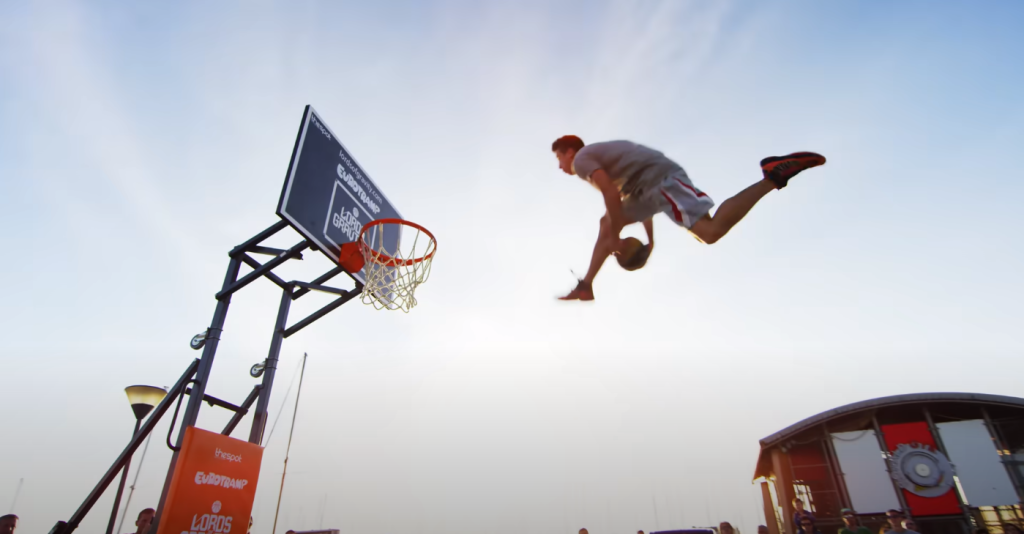The slam dunk – a gravitational defiance and rejection of earthly limitations. In the fleeting moment of a dunk, a player seems to disconnect from the court below, soaring skyward to throw down the ball with commanding force. The crash of the dunk echoes through the arena as the crowd erupts, momentarily suspended in awe.
More than just two points, the slam dunk delivers an adrenaline jolt of athleticism, power, and spectacle. But behind the high-flying finishes lies a complex mix of skill, strength, and style. This iconic move has evolved from a seldom-seen novelty to a staple display of basketball showmanship.
If you want to estimate how high you can jump and dunk a basketball, input your measurements into an online dunk calculator to get an approximate vertical leap.
This article will explore the exhilarating world of the slam dunk. We’ll decode the mechanics that launch players to rim-rattling heights. We’ll trace the history and development of the dunk through the decades. And we’ll provide tips on mastering this gravity-defying feat, from backboard-shaking throwdowns to smooth finger rolls. Whether you’re a seasoned veteran of dunk contests or just dreaming of your first rim-grazer, this guide will give you a new appreciation for basketball’s signature statement.
Table of Contents
Sky High: Decoding the Mechanics of a Slam Dunk
What does it take to propel a player nearly four feet off the hardwood for a rim-rocking slam dunk? An explosive combination of power, timing, and skill. The masters of the dunk combine incredible leaping ability with acrobatic ball control to throw it down with authority.

Vertical Takeoff
Generating enough lift for a dunk requires tremendous lower body strength. Elite dunkers have incredible leaping ability, with vertical jumps averaging over 40 inches. Here’s a look at the hops of some of the NBA’s high-flyers:
| Player | Vertical Leap |
|---|---|
| Michael Jordan | 48 in |
| Vince Carter | 43 in |
| Zion Williamson | 45 in |
| LeBron James | 44 in |
Ball Control in the Clouds
Once airborne, dunkers display remarkable hand-eye coordination to catch and control the ball above the rim. Different grips give players options on their throwdown:
- Palm grip – Controlling the ball with the palm and fingers allows for power dunks like two-handed slams.
- Claw grip – Grabbing the ball with the fingertips enables greater control for single-handed jams.
Guiding the ball into the hoop requires flawless midair dexterity. The perfect trajectory and finish can turn an athletic dunk into an artistic masterpiece.
Finishing with Flair
There are countless ways to throw down, combining athleticism with personalized style:
- Power dunks – Nothing asserts dominance like a rim-rattling two-handed slam, a la Shaquille O’Neal.
- Acrobatic dunks – Contorting the body midair for circus-style alleys oops, like those executed by Aaron Gordon.
- Finger rolls – For the grace of gliding to guide the ball in with one hand, perfected by Michael Jordan.
The most iconic dunkers have signature moves that pay homage to their on-court personas. Dominique Wilkins’ windmill jams expressed unbridled power. Julius Erving’s free-throw line dunks embodied weightless improvisation. The dunk provides the ultimate canvas for basketball innovation and expression.
A Leap Through Time: The History of the Slam Dunk
While today’s high-flyers seem to spend as much time above the rim as on the court, the dunk was not always a staple of basketball. The electrifying move evolved from a rare novelty to an indispensable part of the game.
From Humble Beginnings to Soaring Heights
The dunk has roots in the early days of basketball. As far back as 1936, dunks were described in a New York Times article. But it was not until the 1960s that players began taking flight with regularity.
Towering figures like Wilt Chamberlain and Lew Alcindor (later Kareem Abdul-Jabbar) demonstrated the shot-blocking, score-settling power of the dunk. Other athletic pioneers like 6’4″ leaper David Thompson pushed the boundaries with acrobatic aerial moves.
The dunk riled traditionalists, who saw it as showboating. But fans were captivated, and the dunk’s popularity soared. In 1976, dunks were officially sanctioned by the NCAA, cementing their status as a legitimate weapon in the basketball arsenal.
Evolution of the Dunk
In the 1980s and 90s, dunking prowess reached new heights. Players like Dominique Wilkins and Michael Jordan wowed crowds with thunderous throwdowns. The advent of the slam dunk contest provided a showcase for ever-more-acrobatic jams. Stars incorporated ballet-inspired grace and gymnast-like midair contortions to pull off physics-defying feats.
Today’s elite leapers like Aaron Gordon and Zach LaVine continue to push the limits of hang time. Signature dunks have become ingrained in basketball’s visual vernacular, recalling the legends who made them famous. The dunk has cemented its place as one of basketball’s most exciting and iconic sights.
Beyond the Basket: Cultural Impact of the Slam Dunk
The slam dunk has transcended basketball to embed itself in popular culture:
- Movies/TV – From Space Jam to televised contests, the dunk reels in viewers.
- Video games – Titles like NBA Jam incorporate over-the-top dunking action.
- Music – Dunks are immortalized in songs from rapper lyrics to sports arena anthems.

Certain jams live on as cultural landmarks thanks to their elegance, power, or improbability. Dr. J’s floating swoop from the free throw line. Michael Jordan’s gravity-defying kiss off the backboard. Such images pass into basketball mythos, acting as timeless testaments to the endless possibilities of human potential.
From Playground to Poster: Mastering the Slam Dunk
While dunking may seem like a superpower reserved for elite athletes, with dedication and proper technique, many can learn to get air and throw it down with authority. Here are some tips to help you rise up to dunking glory:
Training for Takeoff
Start by building the core strength and leg power needed to gain lift:
- Squats/lunges/box jumps – Develop explosive lower body power.
- Core exercises – Strengthen stability for coordinated movement.
- Cardio – Improve stamina and fast-twitch muscle capability.
| Exercise | Sets x Reps |
|---|---|
| Squats | 4 x 8 |
| Calf Raises | 4 x 15 |
| Plank | 3 x 30s |
Practice vertical leaping drills, focusing on proper takeoff form. Gradually increase height and difficulty over time. Proper technique is crucial to avoid injury.
Mastering the Mechanics
Break dunking down into manageable steps. Start with lower rims to learn fundamental skills:
- Body control – Practice coordinating approach steps and jumps without a ball.
- Basic dunks – Work on layup motions with one and two hands at lower heights.
Once the basics are solid, start attempting dunks at game height, first without a ball. Add the ball once able to repeatedly touch the rim. Taking time to build skills will lead to big air.
Safety First
It’s essential to build up gradually to avoid injury. Some key safety tips:
- Always warm up and stretch thoroughly before attempting dunks.
- Use appropriate footwear with good traction and support.
- Don’t practice dunks without experienced spotters, especially when fatigued.
- Know your limits – better to miss a dunk than land dangerously.
With practice and patience, the rim awaits your thunderous rejection of its tyrannical limits. Just remember to respect your body’s boundaries as you explore the endless possibilities above the court. The sky is the only limit.
FAQ
How high does someone need to jump to dunk?
The exact jumping height needed to dunk varies by a player’s height and arm length, but most experts estimate you need to be able to touch at least 10 feet on a regulation 10-foot high basket. Many pro dunkers can jump over 40 inches high.
Who was the first player to dunk in the NBA?
Joe Fortenberry is widely credited with performing the first dunk in an NBA game in 1936. However, dunks did not become popular in games until the 1960s when players like Wilt Chamberlain brought athletic dunking into the mainstream.
What is the difference between a slam dunk and a regular dunk?
A slam dunk involves forcefully throwing the ball down into the hoop with power, while a regular dunk just involves putting the ball in the basket above the rim. Slam dunks add an extra level of athleticism and dominance.
What are some different types of dunks?
Some popular dunk types are:
- Two-handed power dunks
- One-handed tomahawk dunks
- Alley-oops off passes from teammates
- Reversed or backward dunks
- Between-the-legs dunks
- Windmill dunks involving spinning hands
What is the optimal hand position for dunking?
The palm dunk with fingers spread wide and wrist cocked back allows players to grip the ball firmly and control it. For alley-oops, the claw grip with fingertips can allow more catching flexibility.
How high is the rim for NBA dunking?
The official NBA rim height is 10 feet. Most players can dunk on rims from 8-10 feet. Lower heights allow beginners to practice dunk mechanics before reaching elite jumping status.
What exercises can improve someone’s vertical leap for dunking? Squats, lunges, calf raises, plyometrics, and other explosive power drills are great for increasing leaping ability and vertical jump height. Core strength is also key.
What are some tips for completing your first dunk?
Start low, perfect your technique, build gradually up in height, use proper form on takeoff and landing, gain momentum on approach, stretch thoroughly, and use quality equipment to avoid injury. Enlist spotters when learning dunks at high rims.






Leave a Reply